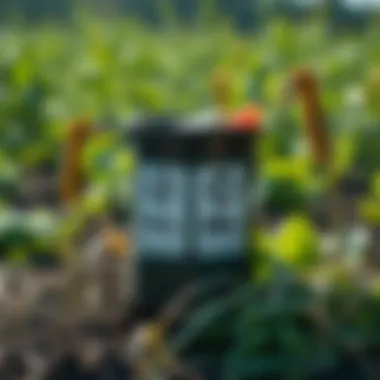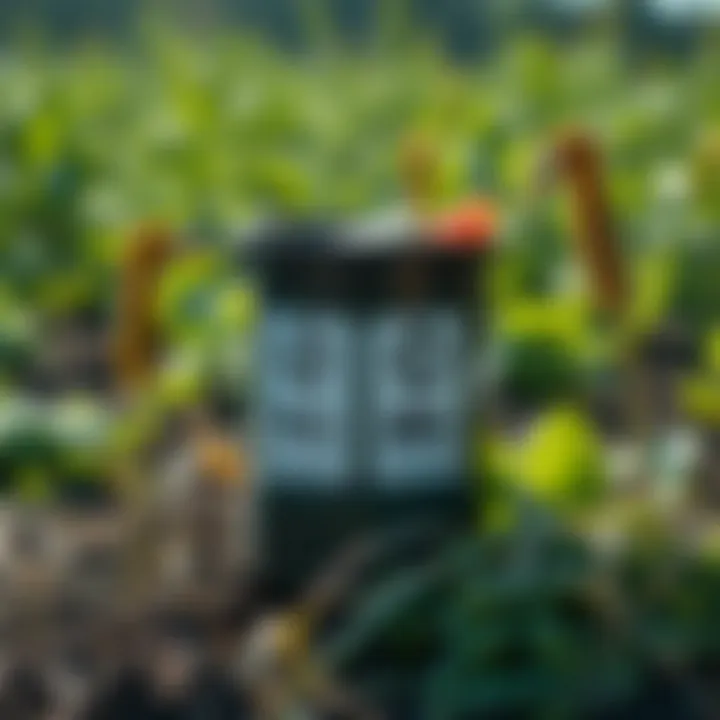Exploring Agricultural Waste Statistics and Management


Intro
Agriculture is a cornerstone of our global economy, feeding billions while also posing significant challenges related to waste. With an ever-growing population, the agricultural sector faces mounting pressure not only to produce food but to do so sustainably. Understanding waste statistics is crucial in achieving a balance between productivity and environmental stewardship. By examining the generation, management, and recycling of waste in agriculture, we can unlock insights that are essential for developing sustainable practices.
In this article, we will explore a plethora of issues surrounding agricultural waste, including its sources, environmental impact, and some path towards better management practices. The need for clear, informed strategies is urgent as farmers and enthusiasts alike strive for resilience in their practices.
Key Insights
Overview of the Topic
Waste in agriculture encompasses a broad spectrum of materials—everything from livestock manure to unused crops. As daunting as it might seem, this waste can be categorized into various streams, each contributing uniquely to the complexities of waste management.
Tools like the Food Waste and Recovery Report provide a window into these issues by highlighting the staggering amount of produce that never reaches consumers. Addressing this problem not only helps reduce waste but can enhance food security somewhere down the line.
Importance in Agriculture/Horticulture/Agronomy
The importance of tackling the waste issue in agriculture cannot be overstated. First and foremost, it has significant environmental implications. Agricultural waste can lead to soil degradation, water pollution, and air quality deterioration. However, there’s a silver lining: with innovation and commitment, many farmers are successfully transforming waste into valuable resources.
Understanding waste statistics allows stakeholders to identify hotspots of inefficiency and—critically—opportunities for recycling and waste reduction. By harnessing these statistics, agricultural practices can evolve, promoting a more sustainable environment for future generations.
"Waste is not a waste until wasted."
Sustainable Practices
Eco-Friendly Techniques
Implementing sustainable practices in managing agricultural waste is not just a fad; it is becoming a necessity. Some eco-friendly techniques include:
- Companion Planting: Utilizing certain plant species to enhance soil quality and deter pests, thus reducing the need for chemical fertilizers.
- Composting: Creating nutrient-rich soil amendments from organic waste not only diverts material from landfills, it enriches the soil.
- Anaerobic Digestion: This process converts livestock waste into biogas, producing renewable energy while minimizing methane emissions.
Each of these methods not only mitigates waste but can also lower costs, creating a win-win situation for farmers.
Case Studies on Sustainability
Looking into specific case studies can provide valuable insights into successful sustainable practices. For instance:
- The Rodale Institute uses a 26-year-old research farm to demonstrate organic farming techniques and the successful management of waste.
- A community garden in South Dakota implemented a composting program that led to significant reductions in organic waste, showcasing not just environmental benefits, but community engagement as well.
Tools & Resources
Essential Equipment and Technologies
In navigating the complexities of waste management in agriculture, the right tools can make a world of difference. Here are some essential items:
- Biodigesters: Useful for turning animal waste into energy.
- High-Efficiency Tillage Equipment: Reduces soil compaction, promoting healthier root systems.
- Soil Moisture Sensors: Help farmers optimize water use, indirectly reducing waste.
Recommended Books and Readings
For those looking to delve deeper into waste management in agriculture, consider these recommended readings:
- The Waste-Free World by J.B. MacKinnon
- Waste to Wealth: The Circular Economy Advantage by Peter Lacy and Jakob Rutqvist
- The Lean Farm by Ben Hartman
In closing, the conversation around agricultural waste is more than a discussion of numbers—it's a call to action. Understanding the intricate details of waste statistics can equip farmers to rethink practices, drive innovation, and contribute to a healthier planet. Through this comprehensive examination, stakeholders within the industry can position themselves not only as stewards of the land but as pioneers in sustainable agriculture.
Understanding Waste Statistics
Understanding waste statistics is more than just numbers arranged in a table; it's a clarion call for awareness in agriculture—a field that underpins our very existence. Farmers and agricultural enthusiasts often find themselves grappling with the sheer volume of waste generated while producing food. By delving into waste statistics, one can uncover the underlying trends, challenges, and impactful ramifications faced by the agricultural sector. The fertility of the land and the health of ecosystems are intimately tied to how we manage waste.
Defining Waste in Agriculture
In essence, waste in agriculture encompasses any product deemed undesirable and discarded during the production, processing, and distribution of agricultural goods. This waste can take on various forms, each with different implications.
- Organic Waste: This includes discarded fruits and vegetables, plant residues after harvest, and livestock waste. Rather than view organic waste merely as trash, it's crucial to recognize its potential as a resource, particularly when it comes to composting and soil enhancement.
- Plastic Waste: The agriculture industry heavily relies on plastic for packaging and tools. While it facilitates modern farming, the improper disposal of plastic can lead to environmental chaos, contributing significantly to land and ocean pollution.
- Chemical Waste: Pesticides, fertilizers, and other chemicals often end up as waste when excess usage occurs or when products expire. These wastes pose severe threats to soil, water, and human health if not handled correctly.
- Electronic Waste: With advancements in farming technology, electronic waste, such as outdated weather stations, sensors, and farm machinery components, is becoming increasingly prevalent. Proper disposal is a must to mitigate environmental impacts.
Understanding what constitutes waste in agriculture paves the way for more effective management practices, ensuring that no valuable resources go to waste.
Importance of Waste Statistics
Understanding waste statistics is essential for several reasons:
- Resource Optimization: By closely examining how much waste is generated and from what sources, farmers can devise better strategies for waste reduction and resource optimization.
- Policy Development: Stats on agricultural waste can guide policymakers in creating regulations that promote sustainable practices and prevent environmental degradation.
- Economic Implications: Greater awareness of waste can lead to cost savings. Finding alternative uses for organic waste, such as creating bioenergy, can open new revenue streams for farmers.
- Environmental Protection: Insight into waste statistics allows for a clearer understanding of environmental impacts. By addressing waste issues, the agriculture sector can play a significant role in combating climate change and conserving biodiversity.
- Social Awareness: Sharing waste statistics with consumers can increase their awareness of sustainability issues, encouraging them to support environmentally responsible practices.
In the grand scheme of things, comprehending these statistics equips stakeholders with the knowledge needed not only to enhance agricultural efficiency but also to contribute to a healthier planet.
"Knowing is not enough; we must apply. Willing is not enough; we must do." - Johann Wolfgang von Goethe


As we navigate the complex web of agricultural practices, the need to understand and address waste cannot be overemphasized. A collective effort in analyzing waste statistics will lead to a more sustainable future.
Types of Waste Generated
Understanding the types of waste generated in agriculture is a cornerstone of effective waste management practices. Delving into organic, plastic, chemical, and electronic waste not only highlights the diverse challenges farmers face but also points to the various pathways for sustainable practices. Each waste type presents unique characteristics that demand specific approaches in management and reduction strategies, thus playing a crucial role in promoting a more eco-friendly agricultural system.
Organic Waste
Organic waste is primarily made up of materials that come from living organisms, mainly plant and animal matter. According to estimates, a staggering 30-40% of all food produced globally goes to waste, which includes organic matter such as spoiled fruits, vegetables, and livestock remains.
The significance of managing organic waste lies in its potential for nutrient cycling. When properly composted, organic waste can enrich the soil, enhance its structure, and increase its microbial activity. This not only mitigates waste but also reduces the need for chemical fertilizers, which can be harmful to the environment.
Proper management of organic waste can reduce greenhouse gas emissions significantly. A well-implemented composting system could cut down organic waste sent to landfills by as much as 50%.
Farmers can adopt several strategies to handle organic waste effectively:
- Composting: Turning waste into valuable fertilizers.
- Anaerobic digestion: Generating biogas while managing waste.
- Utilization in feed: Converting food scraps into livestock feed.
Plastic Waste
Plastic waste in agriculture usually stems from the use of plastic wraps, containers, and irrigation systems. The prevalence of plastic is alarming. Research suggests that in many regions, plastic waste can account for over 20% of the total agricultural waste.
The key issue with plastic waste is its lasting impact on the environment, as traditional plastics can take hundreds of years to decompose. This leads to soil degradation, water contamination, and harm to wildlife. Addressing this issue requires a multi-faceted approach:
- Recycling: Using programs to collect and process agricultural plastics.
- Biodegradable alternatives: Exploring the feasibility of biodegradable materials in agriculture.
- Community awareness: Educating farmers on the importance of reducing plastic usage.
Chemical Waste
Chemical waste typically includes fertilizers, pesticides, and herbicides that are improperly disposed of or unused residue from agricultural operations. This type of waste poses serious risks to both human health and the environment. Improper disposal methods can lead to soil contamination and water pollution, adhering to the concept of bioaccumulation in ecosystems where chemicals can build up over time.
Understanding the implications of chemical waste informs vital practices:
- Safe Disposal: Following regulations for disposal ensures chemicals do not enter the environment.
- Integrated Pest Management (IPM): Reducing reliance on chemical pesticides through alternative methods.
- Education on risks: Making farmers aware of safe handling and amounts of chemical usage.
Electronic Waste
Electronic waste, or e-waste, in agriculture is an emerging concern with the increasing reliance on technology, such as sensors and drones. Outdated equipment can accumulate rapidly, creating significant waste that is often hazardous due to the materials used in electronics.
Managing e-waste involves:
- Recycling Programs: Establishing infrastructure to handle e-waste appropriately.
- Refurbishing Equipment: Extending the life of devices through repair and upgrades.
- Awareness Campaigns: Promoting responsible disposal and recycling of electronic components.
By adopting effective management strategies across these waste types, the agricultural sector can significantly lessen its environmental footprint and move toward more sustainable practices. Each step taken not only benefits the individual farmer but also contributes to the broader goal of environmental stewardship.
Quantitative Insights
Understanding the quantitative aspects of waste in agriculture is crucial for several reasons. It allows farmers and stakeholders to grasp the full picture of waste generation, disposal methods, and their overall environmental impact. With accurate data, effective strategies can be developed to minimize waste and promote sustainability.
By analyzing waste statistics, stakeholders can identify major sources of agricultural waste, whether it's organic, plastic, chemical, or electronic. This understanding enables the formulation of targeted interventions that could significantly reduce waste output. For instance, knowing how much waste is generated annually allows for better resource allocation and planning. Furthermore, these insights provide a baseline against which progress can be measured over time.
Efficient waste management practices not only contribute to environmental health but also enhance the profitability of agricultural operations. By addressing waste at its source, farmers can reduce costs related to waste disposal, conserve resources, and even generate new revenue streams through recycling and repurposing waste materials.
Global Waste Generation Statistics
Agriculture is a significant contributor to global waste. Recent studies estimate that around 1.3 billion tons of food is wasted each year, with a significant portion originating from agricultural practices. This ranges from crops that are never harvested to surplus produce that does not meet market standards. A significant issue arises from the discrepancies in waste generation statistics across regions.
The Food and Agriculture Organization (FAO) provides comprehensive data on these figures, emphasizing how food waste impacts not just farmers but the entire supply chain. Understanding the numbers reveals a staggering loss of resources, including water, land, and labor. This loss underscores the need for improved management practices and highlights the benefits of reducing waste on a global scale.
Regional Variations in Waste Production
Waste generation varies widely by region due to factors such as agricultural practices, economic conditions, and cultural attitudes toward waste. For instance, in developed countries like the United States, there is a higher rate of consumer food waste, whereas developing nations may struggle with food loss before it even reaches consumers due to inadequate storage facilities.
In the European Union, initiatives such as the Circular Economy Action Plan have been introduced, aiming to address these discrepancies by enhancing waste management practices. For regions heavily reliant on rice farming, like Asia, the issue of straw burning adds another layer to the waste challenge, leading to both air quality issues and loss of potential organic material that could be composted.
Trends Over Time
Analyzing trends over time reveals both improvements and ongoing challenges regarding agricultural waste. Over the last decade, there have been increases in awareness around sustainable practices and waste reduction. This reflects in policies and programs like the Zero Waste Movement, which encourage innovative solutions for repurposing waste.
However, despite some progress, data suggests waste generation could outpace efforts to reduce it, especially as global population numbers rise. A key trend is the shift towards technology in waste management, from precision farming to waste tracking software, allowing for better decision-making through data.
Therefore, continuous monitoring and adaptation are necessary to meet sustainability goals and protect environmental health in agriculture. The integration of modern technologies alongside traditional practices holds the promise for significant reductions in agricultural waste.
In summary, the quantitative insights into agricultural waste reveal not just the magnitude of the issue but also the pathways to a more sustainable future.
Environmental Impact of Agricultural Waste


Waste generated from agricultural activities has far-reaching effects on our environment, touching everything from soil health to water quality and even the very biodiversity we rely on. Understanding these impacts is key to developing effective waste management strategies that not only minimize detrimental effects but also promote sustainability. In this section, we will explore how agricultural waste—whether it is organic, plastic, or chemical—affects the environment and the intricate web of life it sustains.
Soil Degradation
Soil is not just dirt; it's a living entity influencing the health of crops. When farmers dispose of agricultural waste improperly, it can lead to soil degradation. This happens when hazardous waste finds its way into the soil, disrupting nutrient balance and harming beneficial microorganisms. Over time, this degradation can manifest as decreased soil fertility, which can result in lower crop yields and contribute to the vicious cycle of seeking more chemical fertilizers.
Excessive use of fertilizers, often a response to degraded soil conditions, can also lead to nutrient runoff, causing further contamination of local waterways. Practicing methods like composting can help restore nutrients and structure to the soil, creating a more sustainable approach to agriculture.
Water Contamination
Water is the lifeblood of both agriculture and the environment. However, improper waste management in agriculture can lead to significant water contamination. Chemical fertilizers, pesticides, and herbicides frequently used in farming can leach into nearby streams and rivers, a phenomenon often referred to as runoff. This not only impacts drinking water quality but can also create dead zones in aquatic ecosystems, where oxygen levels plummet, and life struggles to survive.
Furthermore, organic waste that’s not handled properly can introduce pathogens and excess nutrients into water bodies. High levels of nitrogen and phosphorus can lead to algal blooms, which are harmful to aquatic life and can disrupt local fishing economies. Implementing best practices in waste management is crucial for preserving water quality and ensuring healthy ecosystems.
Biodiversity Loss
When agricultural practices neglect waste management, biodiversity can take a serious hit. Pesticides and fertilizers not only target pests but can also harm non-target species, leading to a decline in beneficial insects and native plant life. This loss of biodiversity disrupts the balance of ecosystems, making them more vulnerable to pests and diseases—ironically, leading some farmers to use even more chemicals in an attempt to compensate.
Additionally, the conversion of natural habitats for agricultural use often leads to habitat destruction, particularly for endangered species. Integrating sustainable practices, like crop rotation and organic farming, helps restore natural habitats and supports wildlife. By encouraging practices that respect the ecosystem, farmers can play a pivotal role in preserving biodiversity, which is essential for resilient agricultural systems and healthy food production.
"Healthy soil, clean water, and vibrant ecosystems are the foundations of sustainable agriculture and food security."
In summary, the environmental impact of agricultural waste is a critical topic that demands attention. By understanding the issues related to soil degradation, water contamination, and the loss of biodiversity, farmers can implement better waste management practices that not only enhance their productivity but also safeguard our environment for future generations. Whether through composting, responsible chemical use, or innovative recycling, the strategies we employ today can lay the groundwork for a more sustainable agricultural future.
Waste Management Practices
Waste management practices play a crucial role in how the agricultural sector deals with various types of waste. Effective management strategies not only reduce the volume of waste but also minimize its environmental impact. These practices can lead to significant benefits, such as cost savings, improved soil health, and enhanced food safety. Through thoughtful waste management, farmers can turn potential problems into renewable resources, contributing to sustainable farming.
Composting Organic Waste
Composting organic waste is a transformative practice. It allows farmers to recycle kitchen scraps, crop residues, and livestock manure into nutrient-rich compost. By returning this compost to the soil, one can enhance its fertility and structure, promoting better plant growth. Moreover, composting reduces methane emissions that would otherwise occur in landfills. Some farmers, particularly those transitioning to organic practices, have found composting not just beneficial but essential.
"Composting is not just waste management; it’s a pathway to healthier soils and more bountiful harvests."
To get into the nitty-gritty of composting, here’s a short list to consider:
- Choose a variety of greens (nitrogen-rich materials) and browns (carbon-rich materials).
- Maintain proper moisture, often equal to that of a wrung-out sponge.
- Turn the pile regularly to aerate and speed up decomposition.
- Monitor temperature to ensure it's warm enough to kill pathogens.
Recycling Plastics
Recycling plastics used in agriculture can pave the way toward a cleaner environment. Many farmers use plastic for various purposes, including seedling trays, irrigation tubes, and mulch film. Unfortunately, most of these end up in landfills if not managed properly. Recycling programs specifically designed for agricultural plastics can recapture valuable materials and reduce waste.
Farmers can benefit from collaborating with local recycling initiatives. Here are key points to remember when considering plastic recycling:
- Identify local recycling centers or initiatives that accept agricultural plastics.
- Clean your plastics before recycling to enhance the chances of successful processing.
- Engage in community efforts that promote recycling awareness among neighbors and fellow farmers.
Safe Disposal of Chemicals
The safe disposal of chemicals, from pesticides to fertilizers, is paramount for both health and safety. Unchecked disposal can lead to soil and water contamination, with dire consequences for ecosystems and human health. Farmers need to be aware of how to handle unused or expired chemicals responsibly.
Some best practices include:
- Always refer to the product label for disposal guidelines.
- Utilize hazardous waste collection programs when available.
- Store chemicals securely to prevent accidental misuse or spills.
E-Waste Management
As technology integrates deeper into farming, managing electronic waste becomes a growing issue. Old tools such as GPS devices, computers, or drones contain materials that can be harmful if not disposed of correctly. e-Waste not only contributes to landfills but can also leak toxins comparable to hazardous waste.
Farmers should consider these points for e-waste management:
- Look for local e-waste recycling events or facilities in the area.
- Donate functional equipment to schools or non-profits rather than discarding.
- Educate yourself on how to properly dismantle equipment for recyclables.
In summary, effective waste management practices can significantly reshape agricultural practices in a way that promotes sustainability and ecological well-being. By composting organic material, recycling plastics, disposing of chemicals safely, and managing e-waste responsibly, farmers can not only contribute positively to their communities but also ensure that their operations thrive in the long run.
For more detailed insights and information on sustainable waste management in agriculture, consider checking resources from organizations like the Environmental Protection Agency (EPA) или Wikipedia on Waste Management.
Innovative Waste Reduction Strategies
Innovative waste reduction strategies are pivotal in transforming the agricultural landscape. These strategies not only enhance sustainability but also promote efficiency within farming practices. As the agricultural sector grapples with challenges arising from waste management, a holistic approach to reducing waste can yield significant environmental and economic benefits. By focusing on technological advances, sustainable farming practices, and robust policy frameworks, stakeholders can pave the way for a cleaner, more resilient future.
Technological Advances
The digital age has ushered in a spectrum of technological advances that have the potential to revolutionize waste management in agriculture. Precision farming technologies, such as satellite imaging and IoT sensors, enable farmers to monitor crop health and soil conditions in real-time. This precise data allows for more targeted use of resources, reducing excess waste when fertilizers or pesticides are applied.
Benefits of Technological Advances:


- Efficiency in Resource Use: By precisely identifying crop needs, farmers can minimize inputs, thus reducing waste volume.
- Smart Waste Tracking: Technologies like blockchain can enhance tracking and transparency in waste streams, facilitating better recycling and disposal decisions.
- Innovative Composting Solutions: Technologies, such as anaerobic digesters, can convert organic waste into biogas, providing a renewable energy source, drastically reducing methane emissions from landfills.
"The future of agriculture lies in its ability to adapt and integrate new technologies that prioritize sustainability over excess."
Sustainable Farming Practices
Implementing sustainable farming practices is essential for reducing agricultural waste at its source. Crop rotation, cover cropping, and agroforestry are just a few methods that not only enhance soil health but also contribute to waste minimization.
Considerations for Sustainable Practices:
- Biodiversity: By promoting diverse ecosystems, farmers can lower dependency on chemicals, leading to reduced chemical waste.
- Soil Health Improvement: Intact soil from sustainable practices can retain nutrients better, thus lessening the need for chemical fertilizers and resulting waste.
- Water Conservation: Techniques like drip irrigation ensure that less water is wasted, also translating to less run-off pollution.
Policy Frameworks and Guidelines
Robust policy frameworks are crucial for promoting innovative waste reduction strategies. These guidelines can establish standards for waste management while incentivizing farmers to adopt cleaner practices. Governments and organizations can work together to develop comprehensive policies that address different waste types more effectively.
Key Aspects of Policies:
- Incentives for Reducing Waste: Offering subsidies or tax breaks for farmers who implement waste-reduction technologies or sustainable practices can motivate change.
- Collaboration with Stakeholders: Policies that create collaborative ecosystems among farmers, researchers, and local communities can yield innovative solutions based on shared research and resources.
- Clear Guidelines and Standards: Well-structured guidelines ensure that farmers have the knowledge to implement best practices while complying with regulations, thus promoting accountability and sustainability.
Case Studies of Successful Waste Management
In the realm of agriculture, examining effective waste management practices is an eye-opener for farmers and stakeholders alike. Real-life examples shine a light on the tangible benefits of strategically managing waste, promoting sustainability, and enhancing productivity. These case studies not only provide a roadmap for success but also inspire innovative thinking about what’s possible in waste management. Getting insights from what has worked elsewhere can spark ideas tailored to local conditions, which can be pivotal in combating agricultural waste challenges.
Best Practices in Organic Farms
Organic farms often lead the way in implementing sustainable practices that minimize waste. Their commitment to environmental stewardship demonstrates how thoughtful management can yield not just crops but also a healthier ecosystem. For instance, many organic farmers utilize composting as a primary method for dealing with organic waste. Composting not only reduces waste but also enriches the soil, boosting fertility. A great example comes from a farm on the outskirts of San Francisco, where farmers have turned kitchen scraps and crop residues into rich compost instead of sending them to landfills. They also use cover crops to improve soil structure and prevent erosion, allowing them to effectively manage waste while enhancing their productivity.
Key Practices Include:
- Adopting Crop Rotation: Rotating different crops can balance soil nutrients and minimize pests, leading to less waste.
- Utilizing Green Manures: These cover crops can be integrated back into the soil, thereby enriching it while reducing excess biomass.
- Community Supported Agriculture (CSA): By engaging local communities, farmers can reduce surplus through subscriptions, encouraging consumers to adopt a more sustainable eating habit.
Innovative Recycling Programs
On the recycling front, there are numerous innovative programs sprouting up globally aimed at reducing agricultural plastic waste. One particularly lauded initiative comes from a farm in Australia, where farmers partnered with a local recycling company. They implemented a system for recycling plastic items such as mulch films and irrigation tubing, which are often discarded. Instead of adding to landfill waste, these plastics are collected, cleaned, and processed into new products. This program not only conserves resources but also raises awareness within the farming community about the importance of recycling.
“Every piece of plastic recycled is a step towards a more sustainable future in agriculture.”
Elements of Successful Recycling Programs:
- Education and Awareness: Farmers and their communities must understand the significance of recycling initiatives.
- Convenience: Streamlined processes for collecting and transporting recyclables encourages participation.
- Collaboration: Partnering with local governments or businesses can expand resources and program reach, making it easier to adopt these practices.
Embracing successful case studies from organic farming practices and innovative recycling programs helps to chart a promising path forward for the agricultural sector. Understanding what works allows for real-world solutions, creating a ripple effect that benefits not just farmers, but society at large.
Future of Waste Management in Agriculture
The future of waste management in agriculture is a topic of increasing relevance as our global population expands and the demand for food rises. Understanding how we can better manage agricultural waste has never been more critical, especially as farmers face mounting pressures from both consumers and regulators to adopt more sustainable practices. In this rapidly changing landscape, we need to consider not only the current waste management practices but also what lies ahead.
Emerging Technologies
Emerging technologies hold immense potential for transforming waste management in agriculture. Innovative techniques are being developed that enhance efficiency, cut costs, and minimize environmental impacts. For instance, advancements in biotechnology are paving the way for converting agricultural waste into useful products, such as biofuels and biodegradable materials. Farmers can harness local waste sources to fuel their operations, thus reducing reliance on fossil fuels.
Another technology gaining traction is precision agriculture, which utilizes sensors and GPS mapping. By providing real-time data on crop conditions, farmers can apply fertilizers and pesticides more judiciously, thereby reducing chemical waste. Drones, too, are becoming common tools in monitoring crop health and managing resources more effectively, thus promoting sustainable practices.
The role of artificial intelligence (AI) services cannot be overlooked. With machine learning algorithms, farmers can analyze trends and predict waste generation, allowing for better planning and management. The integration of AI with existing agricultural systems helps in identifying waste hotspots and implementing tailored strategies.
Global Initiatives and Agreements
Global initiatives aimed at tackling agricultural waste are gaining momentum, as countries recognize the urgency of sustainable practices. For example, the Paris Agreement sets a framework for countries to commit to reducing greenhouse gas emissions, which encompasses addressing agricultural waste's role in climate change.
Likewise, the Food Loss and Waste Protocol, supported by the UNEP, calls for transparency in waste statistics and encourages countries to develop measurable targets. Aimed at improving accountability, this initiative fosters international collaboration among nations, NGOs, and the private sector.
Local stakeholders draw insights from these broad agreements and adapt them to community needs. Additionally, various agricultural cooperatives are forming partnerships aimed at sharing best practices, technologies, and resources. This concerted effort helps amplify the importance of effective waste management on a global scale.
"The future of agriculture relies heavily on our ability to innovate and cooperate across borders. Waste management must transition from a local burden to a global opportunity."
In summary, the future of waste management in agriculture is characterized by technological innovations and collaborative global initiatives. This combination could specifically benefit farmers and enthusiasts alike by highlighting the importance of sustainable practices that are both economically viable and environmentally friendly. The challenge lies not only in implementing these technologies and policies but also in educating and engaging the agricultural community to work together in achieving lasting change.
End and Call to Action
At the heart of tackling waste in agriculture lies a dual approach of reflection and action. Understanding waste statistics isn't just an academic exercise or a regulatory requirement; it's a vital touchstone that shapes the future sustainability of agricultural practices. As we've explored throughout this article, the challenges posed by various types of waste—be it organic, plastic, or chemical—are immense yet manageable.
A well-informed farmer or agricultural enthusiast can leverage waste statistics to see beyond the numbers. It’s not merely reporting waste generation; it’s an unexpected glimpse into operational efficiency. By reflecting on current methods, farmers can identify opportunities, indicating whether their practices are leading to waste or serving as a model for efficient resource use. Moreover, this data empowers farmers to advocate for necessary changes in policies that can enhance resource use in their communities.
Encouraging engagement is equally essential. Practical engagement transforms theoretical knowledge into tangible outcomes. So how do we encourage this? First, it starts at the grassroots level—community workshops, local farmer meetings, and online forums can serve as platforms to share insights on waste reduction strategies and success stories. Secondly, putting statistics front and center in decision-making processes promotes accountability and a shared responsibility among farmers. Consistent evaluation of waste management practices fosters an environment where innovative ideas can flourish.
- The following steps can enhance practical engagement:
- Build community networks focused on sustainability.
- Share successful waste reduction techniques and outcomes.
- Advocate for local initiatives that promote resource circularity in farming.
Ultimately, the path forward demands a conscious commitment to minimize waste while maximizing sustainability. As you reflect on the insights presented in this article, remember that every small effort contributes to a larger purpose. Let us encourage one another to embrace this challenge actively. It's time to turn data into action, breathe life into policies, and cultivate a greener future. With the knowledge gained, the onus is now on every individual in the agriculture sector to roll up their sleeves and commit to change. Together, we can make a difference, one farm at a time.







